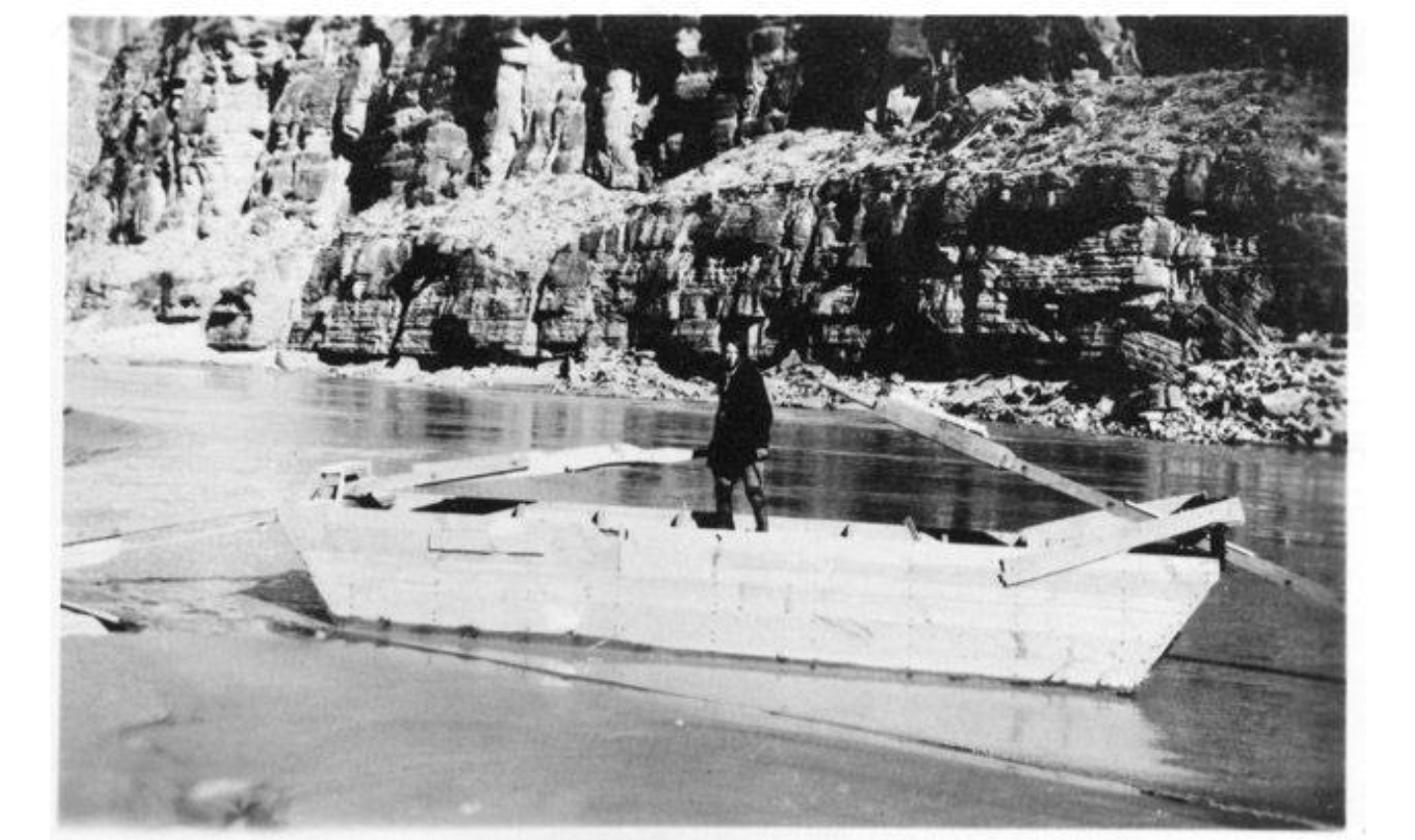It’s the curious case of honeymooners Glen and Bessie Hyde. They went on a journey down the Colorado, never to be heard from again
Legends are almost always based in fact. It starts with a story around the campfire, a teasing old woman, an already mysterious disappearance, and turns into something grander, something surreal.
Something that is whispered in the night.
Add into this legend the mighty Colorado River, a honeymooning couple, and one of the largest searches the Grand Canyon has ever seen, and it is the perfect recipe for a story that can survive for nearly 100 years.
And that story, that myth, that legend all begins with Glen Rollins Hyde and his new bride Bessie Louise Hyde nee Haley.
The Honeymooners
Bessie Haley, born Dec. 29, 1905 in Takoma Park, Maryland, met Glen Hyde at college in San Francisco. Hyde, born Dec. 9, 1898 in Spokane, Washington, was an Idahoan farmer who told the 24-year-old art student all about river running. From the Salmon River in Idaho to the Peace and Fraser Rivers in Canada.

This awe, this passion, quickly won Bessie’s heart, and the two were married in the spring of 1928 in Twin Falls, Idaho.
For their honeymoon, Glen wanted to try to run the Colorado River. In Green River, Utah he made a sweep scow — a large wooden boat some 20-feet long — and they set out on their 600-mile trip to Needles, California, on Oct. 22, 1928 well-stocked and ready to face anything the river had to offer.
Running the Colorado
This October honeymoon trip was meant to be a record breaker, in more ways than one.
According to a Mohave County Miner article in November 1928, the couple was on a record-setting pace. They had been on the river for 26 days when they reached Bright Angel Creek in the South Rim of the Grand Canyon and they had an estimated three weeks left before they reached Needles.
But the running time wasn’t a sure record. What was a sure record was the fact that Bessie Hyde is the first woman to descend the Grand Canyon, a feat more commonly associated with University of Michigan botanist Elzada Clover and her student Lois Jotter in 1938 as part of Norm Nevill’s expedition.
However, Bessie completed the descent a decade earlier.
Another record that was meant to be broken on this trip was that the couple intended to run every rapid. At the time, this wasn’t normal. The usual way to run the river, or any river, was to line the boat over the rapids — having people on the shore with ropes guiding the boat down the rapid — rather than riding all of the rapids.
By all accounts, the Hydes should have gone down in history for a series of firsts and a series of records. They should have reached Needles and been heralded as some of the greatest river runners to exist.
But no one can tame the Colorado.
The Last Sighting at Bright Angel Creek
The Hydes had arrived at Emery Kolb’s studio on Nov. 15, 1928.
Kolb, a Grand Canyon photographer, took them in for their stay and helped answer any questions that he could about the upcoming stretch of the river. He was impressed by their success.
Bessie told Kolb about the times Glen had already been thrown into the water by the rapids, namely the Sockdolager rapids, and how she barely managed to get him the rope in time. Bessie, a petite woman, had managed to hold on to the sweeps and toss Glen a rope. Without a life preserver, Glen’s chances of swimming those particular rapids were slim at best.
And the Hydes had no life preservers.
Kolb was appalled that Glen and Bessie were running the river without life preservers, and tried to get the Hydes to take some of his. He wrote that they looked each other, smiled, and said they shouldn’t need them as they were excellent swimmers. He tried again to make them take some sort of safety equipment, even an intertube, but again the Hydes refused.
Kolb let the couple go.
“My wife and daughter drove them to the head of the trail. Mrs. Hyde looked at my daughter’s shoes and said ‘I wonder if I shall ever wear pretty shoes again,’” Kolb wrote Barry Goldwater of the Arizona Historical Foundation.
They brought tourist A.J. Sutro with them from Bright Angel Creek to Hermit Rapids, a relatively calm stretch of river to enjoy, and put him ashore.
As they disappeared around the bend of the river, waving to Sutro on shore, it would be the last time anyone ever saw the Hydes.
The Search for the Lost Hydes

The Hydes never made it to Needles. They were two weeks overdue, and Glen Hyde’s father Rollin Hyde put into motion one of the largest searches the Grand Canyon has ever seen.
Rollin petitioned Emery Kolb, who was away for surgery on his appendix, for help.
“I realize this is likely of no avail, but I wish to leave nothing undone that can be done.”
Kolb left immediately, and never did end up getting his appendix taken out.
Glen and Bessie’s boat was found, intact, 46 miles from the mouth of the Grand Canyon at 232 Mile Rapid Dec. 1, 1928. It was about 14 miles below the mouth of Diamond Creek. Everything was still on board: food, guidebook, diary, gun, dry clothing and boots.
But there was no trace of Glen or Bessie.
Some tracks were found that were believed to be the Hydes seven miles above Diamond Creek, and farther down Glen’s tracks were found along a rapid.
They led to the river and did not return.
Kolb had his own theory, based on what he knew of the couple’s usual plan of action. Bessie would stand on the bank holding the scow’s rope while Glen walked ahead to examine the next rapid. Possibly she had been pulled or blown into the river — weather at the time was particularly squally — and he had jumped in to save her.
The scow, in theory, floated for five miles until its trailing rope caught on the rocks and held it.
But only the Colorado River knows what really happened to that young Idaho couple who never got to finished their honeymoon.
Does anyone know what happened?
Of course there are rumors that surround this case, theories of what happened that winter on the Colorado River. Tales of murder, hikes, different identities, and an old woman who claims to be the missing Bessie Hyde.
In the 1971, a group of people decided to try to run the Colorado River with guides. Among them was a 60-year-old woman called Elizabeth Arnold Cutler.
After a particularly hard day on the water, everyone in the trip was gathered around the campfire to tell stories. And that was when Rick Petrillo, one of the guides, began telling the story of Glen and Bessie Hyde. He told of the last time they were seen, when Bessie looked at Emery Kolb’s daughter and her shoes and said “I wonder if I’ll ever wear pretty shoes again?”
All was quiet around the campfire after the story, and that was when this “very thin and wiry” woman spoke into the fire “I’m Bessie Hyde.”
The boatmen smiled and laughed and asked her if she was Bessie, what happened to Glen?
“I killed him. Somewhere along here, we had a real bad fight and he beat me up. So late that night I got a knife and stabbed him.”
Elizabeth Arnold Cutler responded.
The guides stood around the campfire grinning and laughing and said “Well, now we know.” They even took to calling Cutler “Bessie” during the trip. To which the woman would teasingly respond.
But was she the missing Bessie?
Chances are she wasn’t. Liz Cutler claimed to have no recollection of the story she told that night on the river when asked by journalists years later, and she had never heard of the Hydes. It was a legend that grew beyond all recognition, even for those who were with her on the river.
“I was surprised when I got back in ‘82, after being away from the story for a long time, to find it was a big story,” recalled George Billingsley, who was one of the river guides. “But it sure got to be a widespread story being told every day in the Canyon. You can grab hold of a rumor and remember it for 50 years, exactly the way that rumor happened. Never miss a lick. But it’s still based on nothing.”
And it didn’t help matters when in 1981 a skeleton was found in a boat in the rafters of the Kolb Studio which ha a silver belt buckle like Glen Hyde’s. The skeleton had a bullet hole, .30 or .32 caliber, through the head.
Rumors spread fast that this was Glen Hyde. This man, the rumors said, was killed, possibly by Emery Kolb who lusted after Bessie. A crime of passion. However, Jack Judd of the Coconino County Sheriff’s Office and forensic anthropologist Walter Birkby at the University of Arizona disproved that theory. The bones were not Glen Hyde.
Over the nine decades since their disappearance, several of these rumors of either Glen of Bessie Hyde showing up, have circulated and spread.
“Yet every spicy myth about the reappearance of Glen or Bessie Hyde withers in the glare of rigorous examination,” wrote author Jack Dimock in Sunk Without a Sound: The Tragic Colorado River Honeymoon of Glen and Bessie Hyde. “As tempting and intriguing as it is to imagine one or both of the Hydes escaping to a new life, there is not a shred of evidence to support it.”
This case has inspired legends, stumped detectives and has left far more unanswered questions than answers.
It is one of those unsolved mysteries. A legend whispered around campfires. The silent waters of the Colorado moving steadily onward, never spilling their secrets.

